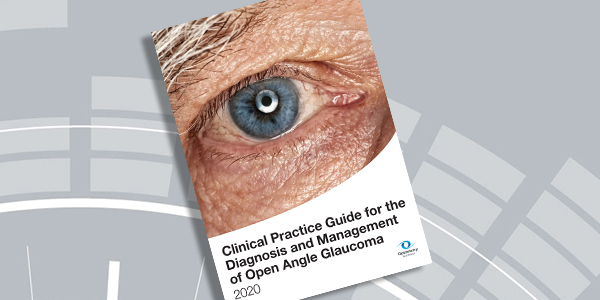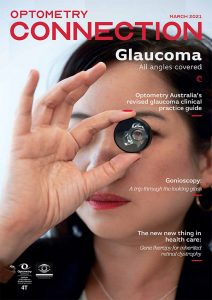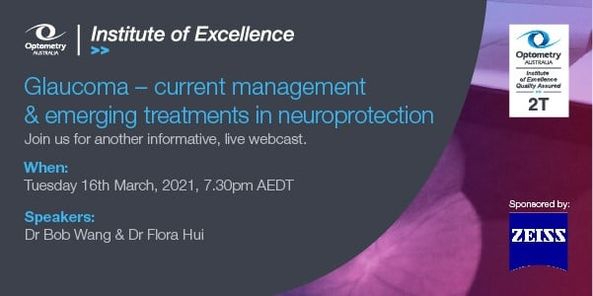1:30min

By Helen Carter
Journalist
Optometry Australia has produced a comprehensive new clinical practice guide on glaucoma to help members implement the most recent evidence into their practice to better care for glaucoma patients.
The Clinical Practice Guide for the Diagnosis and Management of Open Angle Glaucoma 2020 has been uploaded on our website in time for World Glaucoma Week March 7-13, updating our previous guidelines from July 2016.
The new guide provides evidence-based information about current best practice in the management of glaucoma but is a general guide for optometrists and not a formal management protocol.
More emphasis is now placed on:
- diagnosis requiring the integration of clinical findings including examination of the optic nerve head and visual fields for characteristic, concordant signs;
- consideration of risk factors;
- examination of the disc on all patients;
- concordance of structure and function;
- individualising the treatment plan;
- high-quality examination techniques and data-driven diagnoses;
- glaucoma as a diagnosis of exclusion and ruling out all other possible optic nerve head or neurological conditions.
A working group of optometrist clinicians and academics with an interest in glaucoma care, led by co-chairs Optometry Australia Policy and Advocacy Advisors Cassandra Haines and Kerryn Hart, and Head of the Glaucoma Unit at the Centre for Eye Health optometrist Dr Jack Phu reviewed the literature and produced updated recommendations due to the field evolving quickly.
The guide covers definitions, detection, ocular structure, assessment, imaging, diagnosis, management, medication and surgical treatment options, emerging therapies, patient compliance and review, and collaborative care.
An invaluable table of IOP medications available in Australia for glaucoma management includes mechanism of action, efficacy, daily dosage, order of treatment choices, ocular and systemic side-effects and contraindications.
There are helpful tables on risk factors, pseudoexfollation and pigment dispersion syndrome, glaucomatous optic disc features, equipment required, stages, a grading scheme for angle closure spectrum disease, and surgical options.
The risk factor table has also been turned into a handy clinical resource on risk factors in the special March glaucoma edition of Optometry Australia’s new CPD magazine, Optometry Connection, online now, with hard copies arriving in the mail to members this week.
The guide does not replace guidelines on glaucoma management provided by regulatory agencies including the Optometry Board of Australia, and we recommend it be read in conjunction with the National Health and Medical Research Council (NHMRC) Guidelines for the Screening, Prognosis, Diagnosis, and Management of Glaucoma (2010).
Key changes
Dr Phu did the literature review for the working group and wrote an overview of the guide in Optometry Connection’s March 2021 glaucoma edition out now.

‘Since the publication of the last set of Optometry Australia clinical guidelines in 2016 there has been a number of changes in our understanding of glaucoma clinical care,’ Dr Phu wrote.
Key changes, documented by Dr Phu, include:
- There is no single ‘lesion’ within the eye that defines glaucoma. Instead, diagnosing glaucoma requires the integration of clinical findings including careful examination of the optic nerve head and visual fields for characteristic, concordant signs. The combinatory process also includes the consideration of risk factors for glaucoma, which may lead a clinician to lean towards or away from glaucoma.
- Several risk factors have been identified to contribute to development. Perform a comprehensive examination of the disc on all patients, followed by the application of risk factors to guide review and management.
- There is now less emphasis on quantitative ‘cut-off’ values, eg. cup-disc ratio, intraocular pressure, an absolute ‘number’ of signs of glaucoma present, and more emphasis on concordance of structure (integrity of neural tissue) and function (retinal nerve fibre layer bundle visual field defects.))
- There is now less emphasis on prescriptive intraocular pressure reduction treatment targets and mandated follow-up plans and more emphasis on individualising the treatment plan based on patient characteristics (e.g. demographics) and disease trajectory.
- There is now less emphasis on soft signs of glaucoma – disc haemorrhages, peripapillary atrophy, and other risk factors – as diagnostic markers of glaucoma and more emphasis on high-quality examination techniques and data-driven diagnoses (eg. more follow-up examinations, intraocular pressure profiling.)
- There is now less emphasis on glaucoma as the foremost diagnosis of optic nerve head disease and more emphasis on glaucoma as a diagnosis of exclusion, and clinicians need to rule out all other possible optic nerve head or neurological conditions.
Members can listen to Dr Phu and Cassandra Haines summarise the guide in this podcast

Free resources to promote Glaucoma Week
The disease affects more than 300,000 Australians with half unaware they have it because they haven’t had a comprehensive eye exam. In Australia cases are expected to increase to 379,000 in 2025 when costs are estimated to reach up to $4.3 billion.
Known as the ‘silent thief of sight’ glaucoma develops slowly for most people, and a considerable amount of peripheral vision may be lost before the problem becomes apparent. There is no cure and vision loss is irreversible, making early detection and treatment key to saving sight.
The guide says: ‘As primary eye care practitioners, optometrists are ideally positioned to detect patients who have risk factors for glaucoma during routine eye examination. It is the responsibility of all optometrists, whether therapeutically endorsed or not, to detect glaucoma suspects and those with glaucoma at routine eye examinations.’
Glaucoma Australia has created a new awareness campaign, ‘Treat Your Eyes’ to encourage Australians to have an eye examination for World Glaucoma Week, 7 – 13 March 2021. Rock star and glaucoma patient Kirk Pengilly is fronting the campaign aimed at raising awareness and mobilising people at risk to have an eye examination to avoid irreversible damage or blindness.
Glaucoma Australia has created materials to help optometrists raise awareness, increase early detection, and save sight by inviting patients to ‘treat their eyes’ to good health by booking a comprehensive eye exam during March.
Optometrists can encourage people at risk of developing glaucoma to have an eye examination at least every two years, remind those with glaucoma to alert their first-degree relatives about the benefits of regular eye exams from age 40, and Order free patient information resources for their practice.
Glaucoma Australia CEO Annie Gibbins said: ‘Three in one hundred Australians will develop glaucoma yet more than a third have not undergone regular eye examinations, increasing their risk of glaucoma remaining undiagnosed. We need this to change. We hope the Treat Your Eyes campaign can spark Australians into action to get an eye test.’

The new glaucoma guide’s working group comprised:
- Cassandra Haines – Co-Chair – Optometry Australia Policy and Advocacy Advisor, Optometry Victoria/SA Director; Kerryn Hart – Co-Chair – Optometry Australia Policy and Standards Advisor; Jack Phu – Literature review – Centre for Eye Health; Ben Ashby – Optometry Development Manager – Specsavers; James Armitage – Deakin University; Alan Burrow – Private Practitioner; Sandra Au – Queensland University of Technology; Cameron Dyson – Private Practitioner; Graham Lakkis – Private Practitioner; University of Melbourne; Leanne Nguyen – Private Practitioner; Thi Thi Nguyen – Flinders University; Murray Smith – Private Practitioner, Deputy President Optometry Australia, Optometry Victoria/SA Director.
Other glaucoma resources and CPD
Members can also hear about current management and emerging treatments in neuroprotection by registering for our free glaucoma webinar on March 16, worth 2 therapeutic CPD hours.

They can also gain CPD by completing online learning modules, attending CPD events online, listening to podcasts and reading our CPD publications Optometry Connection and Clinical and Experimental Optometry through our Institute of Excellence.
Current glaucoma offerings include:
- Course: Institute Podcasts: Glaucoma Clinical Practice Guidelines (optometry.org.au)
- Optometry Connection’s March 2021 glaucoma special
- New webinar Course: Glaucoma: Current Management & Emerging Treatments in Neuroprotection (optometry.org.au)
- Course: Glaucoma Diagnosis: A Case-Based Interactive Tutorial (optometry.org.au)
- Course: Glaucoma Care and the Future (Webcast) (optometry.org.au)
- Course: Paradigm Shifts in Therapeutic Management of Glaucoma (optometry.org.au)
Tagged as: Clinical practice guides, Glaucoma, Member services, Patient management